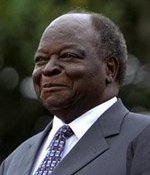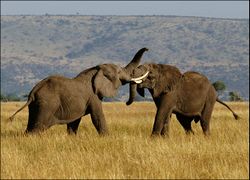كيكويو (شعب)
  | |
| التعداد الإجمالي | |
|---|---|
| (5,347,000 شخص من الكيكويو في كينيا[1],) | |
| المناطق ذات التواجد المعتبر | |
| كنيا | |
| اللغات | |
| الكيكويو, السواحيلية، والإنجليزية | |
| الديانة | |
| المسيحية | |
| الجماعات العرقية ذات الصلة | |
| السواحيليون، أكامبا |
| الشخص | |
| الشعب | Agĩkũyũ |
| اللغة | Gĩkũyũ-House of Mumbi |
كيكويو Kikuyu، هم أكثر الجماعات العرقية إنتشار في كينيا. وأصل تسمية الكيكويو من اللغة السواحيلية جيكويو ويطلقون على أنفسهم اسم شعب الجيكويو. ويصل عددهم إلى 5.347.000 شخص في كينيا (1994 I. Larsen BTL)[1]أي حوالي 22% من إجمالي عدد سكان كينيا[2].
الكيكويو أكبر مجموعة عرقية في كينيا بشرق إفريقيا. ويُعرفون أيضًا باسم الجيكويو ويمثلون نحو 20% من سكان كينيا. ومنهم بعض كبار المتعلمين والأغنياء في كينيا. ويعمل كثير منهم في الحكومة أو الأعمال الحرة والبعض يمتلك مزارع كبيرة.
الأصول
تعود أصول الكيكويو إلى جماعات أتت من الشمال، من منطقة مرتفعات نيامبنه إلى جبل كينيا (كيرنياگا) في الشمال الشرقي، والذي يعتبر هو الموطن الأصلي لغالبية - إن لم يكن لجميع - الشعوب المتحدثة بالبانتو، ومنها ميرو، إمبو، تشوكا، كامبا ومبيره. ويعتقد شعوب الكيكويو أنه استوطنوا منطقة المرتفعات في العقد 1200. وعلى إختلاف المكان الذين أتوا منها، وهي مسألة تحمل الكثير من الجدل (هناك الكثير من الأقاويل المتضاربة والتي تحمل بعض الحقائق): تقول بعض النظريات أنهم أتوا مهاجرين من أكسوم (إثيوپيا) بعد انهيار امبراطورية أكسوم، وآخرون ينسبونهم إلى ‘شونگوايا’، المفترض أنهم كانوا في الصومال، ومنهم انحدرت التسع قبائل التي تدعي ميجيكندا الساحلية النسب إليها. The other main theory posits that they came from the west, having split from the proto-Bantu of central Africa.
ومنذ القرن الخامس عشر الميلادي عاش الكيكيويو فيما يُسمى الآن بكينيا، ويتكلمون لغة يُطلق عليها كيكيويو أو جيكيويو، تنتمي إلى عائلة البانتو من اللغات الإفريقية. وينقسم الكيكيويو إلى تسع عشائر. ومازال الكيكيويو يزرعون ويربون قطعان الأبقار والأغنام حسب الطريقة التقليدية. أما الأراضي فهي مملوكة لرابطة من أفراد مجموعة يُطلق عليها مْباري تتكوّن من أفراد تضمهم صلة القرابة.
Whatever their early origins, it is generally accepted that starting from around the 1500s, the ancestors of the Kikuyu, Meru (including the Igembe and Tigania), Kamba, Embu and Chuka, began moving south into the richer foothills of Mount Kenya. By the early 1600s, they were concentrated at Ithanga, 80 km southeast of the mountain’s peaks at the confluence of the Thika and Sagana rivers.As Ithanga’s population increased, oral traditions of all the tribes agree that the people began to fan out in different directions, eventually becoming the separate and independent tribes that exist today. The theory that the Chuka, Embu, Mbeere, Gicugu and Ndia ‘broke away’ from the main Kikuyu group before arriving at Ithanga is plausible, but is contradicted by the oral traditions of various tribes, many of which include Ithanga in their histories.The Kikuyu themselves moved west to a place near present-day Murang’a, from where the Kikuyu creation myth picks up the story.
Ethnologists believe the Kikuyu came to Kenya from Central Africa together with the other Bantu groups. On reaching present Tanzania, they moved east past Mount Kilimanjaro and into Kenya, finally settling around Mount Kenya, while the rest of the group continued migrating to Southern Africa. They, unlike the Nilotic tribes who were pastoralists, were farmers and began farming the very fertile volcanic land around Mt. Kenya and the Kenyan highlands.However, Kikuyu legends have it that in the beginning, a man called Gikuyu and his wife called Mireia (Mumbi) were placed on Mũkũrwe wa Nyagathanga in present day Murang'a District by God, Mwene Nyaga or Ngai. It was said that they were placed near the Mugumo or Fig tree upon the slopes of the mountain. They gave birth to Nine daughters named,Wanjiku, Wanjirũ, Wangeci, Wambũi, Wangari, Wacera Waithera, Wairimũ and Wangũi. It so happened that when they were grown up, they met nine young men from a distant land, ostensibly Axum, who married the girls and from whom the Kikuyu nation arose. A popular myth claims that when Kikuyu's daughters came of marrying age, Kikuyu prayed to Mwene Nyaga to provide husbands for their daughters whom he duly provided by a fig tree.
وفي عام 1895م احتلت بريطانيا كينيا. وإثر ذلك تغيّرت حياة الكيكيويو بصورة كبيرة تحت تأثير النظام الاقتصادي والتعليمي الغربي. والبريطانيون الذين استقروا في كينيا استولوا على أراضي الكيكيويو وعدّوها ملكًا لهم. وعاش الكيكيويو في فقر لتقلص أملاكهم ونفوذهم السياسي. وأثناء الخمسينيات من القرن العشرين قادوا حركة أطلق عليها الماو ماو عارضت الحكم البريطاني. وفي عام 1952م نشب القتال بين البريطانيين والماو ماو. وبحلول عام 1956م، عندما وصلت أحداث العنف إلى نهايتها تقريبًا، كان عدد القتلى من الكيكيويو نحو 11,500، ومن بقية الإفريقيين نحو 2,000، ومن الأوروبيين والآسيويين نحو 145. واعتقلت بريطانيا كثيرًا من الذين أطلق عليهم لقب المتمردين، ومن بينهم جومو كينياتا قائد الكيكيويو. وانتقل آلاف من الكيكيويو إلى معسكرات الاعتقال بعد تدمير منازلهم.
انتُخِبَ جومو كينياتا رئيسًا لوزراء كينيا بعد استقلالها في 1963م. ثم تغيّر لقبه إلى لقب الرئيس، وكان للكيكيويو دور رئيسي في حكومة كينياتا. ومنذ وفاته في 1978م، عملت الحكومة الجديدة على إيجاد توازن للتأثير على قوى الكيكيويو والجماعات الأخرى.
التاريخ
الزمن لدى الجيوكويو أربع فصول وموسمين حصاد في السنة. وينقسمون إلى التالي:
1- مبورا يا نجاهي - موسم المطر الطويل من مارس إلى يوليو.
2- ماگثا ما نجاهي - موسم الحصاد الكبير ما بين يوليو وأوائل اكتوبر.
3- مبورا يا مويره - موسم المطر القصير من اكتوبر إلى يناير.
4- مگاثا ما مويره - موسم حصاد الدخن.
توسع الكيكويو
مكافحة الاستعمار
ما بعد الاستقلال

جومو كينياتا, هو أول رئيس لكينيا، وينتمي إلى الكيكويو. والرئيس الثالث والحالي مواي كيباكي ينتمي إلى الكيكويو أيضا. فاز كيباكي في انتخابات 2002 فوزا ساحقا ضد مناسفه اوهورو كينياتا، ابن جومو كينياتا أول رئيس للبلاد، بالرغم من مساندة الرئيس دانيال أراپ موي لكينياتا. ووانگاري ماثاي، أول إمرأة أفريقية تفوز بجائزة نوبل للسلام، من الكيكويو، وكذلك الكاتب اليكين الشهير نگوگي وا ثيونگو، والذي يكتب الآن فقط بالكيكويو وبالسواحيلية.
ومن أشهر الرياضيين الكيكويوين:
- Julius Kariuki, the 3,000m steeplechase 1988 olympic champion;
- John Ngugi, 5,000m 1988 Olympic champion;
- Douglas Wakiihuri, a Nagoya and London Marathon Champion;
- Catherine Ndereba, the Boston and Chicago marathon champion
- Charles Kamathi, the 2001 world champion at 10,000m.
- Samuel Kamau Wanjiru Kenyan long distance runner who won the 2008 Beijing Olympic men's Marathon in an Olympic record time of 2:06:32
ونظرا للتنوع الديموغرافي للكيكويو بالإضافة إلى أسباب سياسية واقتصادية أخرى، فإنهم لا زالوا يلعبون دورا حيويا في التنمية السياسية والاقتصادية لكينيا المستقلة.
اللغة
يتحدث الكيكويو لغة الكيكويو، البانتو، وكذلك لغتهم الأم. بالاضافة إلى لغة سواحيلية|السوحيلية، ولغة إنجليزية|الإنجليزية واللغات الرسمية والوطنية المعترف بها في كينيا.
الديانة
يدين غالبية الكيكويو بالمسيحية.
نگاي-الخالق
جبل كيينا والدين
البنية الاجتماعية
التنظيم السياسي التقليدي لشعب الكيكويو
الأجيال الحاكمة [ريكا]
الأجيال الحاكمة [riika] تقتفي تاريخ أگيكويو إلى سنة 1500 تقريباً. 1. Manjiri 1512 – 46 ± 55 2. Mamba 1547 – 81 ± 50 3. Tene 1582 – 1616 ± 45 4. Agu 1617 – 51 ± 40 5. Manduti 1652 – 86 ± 40 6. Cuma 1687 – 1721 ± 30 7. Ciira 1722 – 56 ± 25 8. Mathathi 1757 – 1791 ± 20 9. Ndemi 1792 – 1826 ± 15 10. Iregi 1827 – 1861 ± 10 11. Maina 1862 – 97 ± 5 12. Mwangi 1898?
- Muriuki, Godfrey 1974. History of the Kikuyu 1500 – 1900. (Oxford U Press)
الحياة العائلية
الثقافة
الأساطير
قائمة الكينيين المنتمين إلى كيكويو
سياسيون
- جومو كنياتا، أول رئيس لكينيا (الأب المؤسس لكينيا)
- مواي كيباكي، ثالث رئيس لكينيا
- Uhuru Kenyatta, Deputy Prime Minister, Minister of Finance, Former Minister of Trade, Former Official Leader of Opposition
- Wangari Maathai, Nobel Laureate, first African woman, and the first environmentalist, to receive the Nobel Peace Prize. First woman in Kenya to earn a Ph.D
- Kenneth Matiba, Former MP, Leader of Official Opposition, youngest Permanent Secretary to serve in Kenya, Chairman Alliance Hotels and Hillcrest Schools
- Dedan Kimathi, Field Marshall
- Julius Gikonyo Kiano, former Minister for Commerce and Industry, former Minister for Water Development, Kenya; first Kenyan to hold a Doctorate degree
- Mbiyu Koinange, former Minister of State in the Office of the President, Jomo Kenyatta's closest confidante and brother-in-law of Jomo Kenyatta, first Kenyan holder of a Masters degree (U.S)
- Josephat Karanja, Former Vice President
- Josiah Mwangi Kariuki (J.M. Kariuki), Former Member of Parliament Nyandarua
- Waruhiu Itote aka General China
- Charles Rubia, Former Member of Parliament and Political Activist
- Harry Thuku, Freedom Fighter and Independence Hero
- Peter Kenneth, Member of Parliament, Former Assistant Minister Finance, Former Chairman of Kenya Football Federation, Assistant Minister Ministry of Planning and Development
- Amos Kimunya, Minister of trade, Former Finance Minister and Chairman of Muthaiga Country Club
- Mutahi Kagwe, Former Minister for Information and Communications
- Martha Karua, Former Minister of Justice and Constitutional Affairs
- John Njoroge Michuki, Minister of Environment and Mineral Resources, Former acting Minister of Finance, Former Minister of Roads, Former Internal Security Minister and owner of Windsor Golf & Country Club
- Koigi wa Wamwere, Author and politician
- Gakaara Wa Wanjaũ, Mau Mau Freedom fighter and author
- Charles Mugane Njonjo, Former Attorney General and Minister for Constitutional Affairs
آخرون
- لوسي كيباكي، السيدة الأولى في كينيا
- Samuel Wanjiru, 2008 Beijing Olympic Marathon Champion, 2009 London Marathon Champion, 2009 Rotterdam Half Marathon Champion, 2009 New York Marathon Chapion
- Douglas Wakiihuri, 1987 World Athletic Championships Marathon Champion, 1988 Olympic Marathon silver medalist , 1990 London Marathon Champion, 1990 New York Marathon Champion
- Henry Wanyoike, Paralympics Gold medalalist over 5,000 meters, Holder of various marathon and half marathon records
- Ngugi wa Thiongo, literary scholar
- John Ngugi, World Cross Country Champion four consecutive titles between 1986 and 1989 and five titles overall. 1988 Olympic Champion 5000 metres
- Catherine Ndereba, Four time Boston Marathon Champion, silver medalist in the Olympics in 2004 and 2008. Marathon World Record Holder 2008
- Tom Morello, Grammy Award winning guitarist of kikuyu descent through his father, well known for his tenure with Rage Against the Machine and Audioslave; ranked #26 on Rolling Stone magazine's list of the "100 Greatest Guitarists of All Time."
- James Macharia, Athlete
- Meja Mwangi, Author
- Chris Murungaru, Politician, Former Security Minister
- Eric Wainana, musician
- David Mathenge, musician known as "Nameless"
- مصطفى اوپلاك، كاتب تركي وناشط من أصول كيكويوية
- Martin Tony Waikwa Olsson, Swedish footballer of kikuyu descent who plays for Blackburn Rovers
- Marcus Olsson, Swedish footballer of Kikuyu descent who plays for Halmstads BK in Allsvenskan
- Joseph Kamaru, Musician
- Ngina Kenyatta (Mama Ngina), Former First Lady, Uhuru Kenyatta's Mother, Jomo Kenyatta's widow
John Joseph Kamotho, Former powerful Minister for Education and Secretary General KANU (former ruling party), Kenya Eliud Mathu, First black Kenyan parliamentarian (then known as LEGCO)
مختارات أدبية
- Elkins, Caroline, 2005. "Imperial Reckoning: The Untold Story of Britain's Gulag in Kenya." (Henry Holt and Company, LLC)
- Kenyatta, Mzee Jomo, 1938. Facing Mount Kenya
- Wanjau, Gakaara Wa, 1988. "Mau Mau Author in Detention." Translanted by Paul Ngigi Njoroge. (Heinemann Kenya Limited)
- Lonsdale, John, and Berman, Bruce. 1992. Unhappy Valley: conflict in Kenya and Africa. (J Currey Press)
- Lonsdale, John, and Atieno Odhiambo, E.S. (eds.) 2003. Mau Mau and Nationhood: arms, authority and narration. (J. Currey Press)
- Lambert, H.E. 1956. Kikuyu Social and Political Institutions. (Oxford U Press)
- Muriuki, Godfrey 1974. History of the Kikuyu 1500 - 1900. (Oxford U Press)
- Godfrey Mwakikagile, Kenya: Identity of A Nation, New Africa Press, Pretoria, South Africa, 2008; Godfrey Mwakikagile, Ethnic Politics in Kenya and Nigeria, Nova Science Publishers, Inc., Huntington, New York, 2001.
المصادر
- ^ أ ب http://www.ethnologue.com/show_language.asp?code=kik Accessed 2007/07/09
- ^ CIA Factbook [1] retrieved on October 16, 2007
